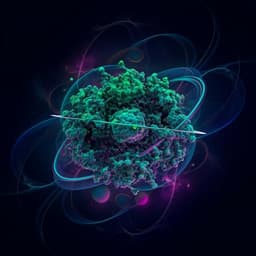
Physics
One-hour coherent optical storage in an atomic frequency comb memory
Y. Ma, Y. Ma, et al.
This remarkable research, conducted by Yu Ma, You-Zhi Ma, Zong-Quan Zhou, Chuan-Feng Li, and Guang-Can Guo, showcases the ability to store light coherently in an atomic frequency comb memory for over an hour. This groundbreaking achievement significantly outstrips previous records and holds promise for the future of large-scale quantum communication.
~3 min • Beginner • English
Introduction
The work addresses the challenge of long-distance quantum communication, which is hindered by photon loss in optical fibers and the complexity of quantum repeater implementations. Space-borne quantum communication and transportable quantum memories offer alternatives, but require optical quantum memories with hour-scale lifetimes to enable global reach. While a six-hour spin coherence time in Eu3+:Y2SiO5 under a ZEFOZ magnetic field with dynamical decoupling has been reported, translating this into long-lived optical storage is difficult due to complex and imperfectly known energy structures in ZEFOZ fields and reduced effective absorption (only one subsite usable). Prior to this study, the longest optical storage times were about 1 minute (in 87Rb and Pr3+:Y2SiO5 using EIT), and ~1 s at the single-photon level in 87Rb. The research goal is to realize hour-scale, coherent optical storage using a spin-wave atomic frequency comb (AFC) protocol in Eu3+:Y2SiO5 under ZEFOZ conditions with dynamical decoupling, enabling faithful storage of photonic qubits for global quantum communication.
Literature Review
Key prior works include: (1) ZEFOZ fields with dynamical decoupling enabling long spin coherence times up to 6 hours in Eu3+:Y2SiO5, providing a resource for long-lived quantum memories. (2) Challenges for optical storage arise from complicated/uncertain energy level structures in ZEFOZ fields and reduced absorption when only one subsite can be used. (3) Longest optical storage prior to this work was ~1 minute in 87Rb and Pr3+:Y2SiO5 using EIT, and ~1 s at single-photon level in 87Rb. (4) AFC is the only protocol that has successfully realized spin-wave storage of photonic qubits in rare-earth crystals, including polarization qubit storage and multimode single-photon storage in Eu3+:Y2SiO5. (5) The best AFC spin-wave optical storage time in Eu3+:Y2SiO5 before this work was 0.5 s with dynamical decoupling. This study builds on these by combining AFC spin-wave storage with ZEFOZ fields and carefully characterized energy structures to achieve hour-scale optical storage.
Methodology
Materials and environment: An isotopically enriched 151Eu3+:Y2SiO5 crystal (site 1), doping 1000 ppm, isotopic enrichment 99.3%, optical depth αL ≈ 2.6, cooled to 1.7 K. The sample (4.5 mm diameter, 6 mm thickness) is oriented so the superconducting magnet’s vertical field aligns with the known ZEFOZ direction; the ZEFOZ magnetic field is 1.280 T along [-0.535, -0.634, 0.558] in the [D1, D2, b] frame. Two-axis goniometers enable precise angular alignment. A pair of 4-turn Helmholtz coils (6 mm diameter) driven by an AWG and 300 W RF amplifier apply dynamical decoupling (DD) sequences.
Laser and optics: A 580.039 nm ultra-stable laser (<10 kHz linewidth) addresses the 7F0–5D0 transition. Pump and probe beams are generated via double-pass AOMs, overlapped in the crystal with waists ~200 μm (pump) and ~50 μm (probe), and intersect at ~30 mrad. Beams double-pass the crystal; the transmitted probe is collected into SMF. Optical heterodyne detection is performed by beating the probe with a reference laser shifted by 43.66 MHz and demodulating the beat signal.
Level structure characterization: The ZEFOZ transition between ground hyperfine states is located by adjusting field strength and sample orientation. Ground-state resonances are probed via continuous-wave Raman heterodyne detection (RHD). Excited-state resonances, not accessible via CW RHD due to short excited-state lifetimes and weaker RF coupling, are measured using pulsed RHD to fully map the hyperfine structure in the ZEFOZ field.
Spin-wave AFC protocol: Preparation begins with spectral hole burning. (1) Class-cleaning: six chirped optical pulses (1 MHz chirp) resonant with selected ground–excited hyperfine transitions isolate a single class of ions; unwanted classes are optically pumped away. (2) Spin polarization: population of the chosen class is initialized into a single ground state (|3⟩) using appropriate pump sequences, yielding a Λ-system comprising |3⟩, |4⟩g, and |3⟩e. (3) AFC preparation: An AFC is created in |3⟩g via frequency-selective hole burning with bandwidth 1.0 MHz and periodicity Δ = 100 kHz, giving two-level AFC echo at t = 1/Δ = 10 μs (effective 1/4Δ considering sequence timing as described). Storage and recall: A 2 μs FWHM Gaussian input probe pulse (150 μW) resonant with |3⟩g↔|3⟩e is absorbed to create a collective optical excitation. A control pulse (4 μs, 360 mW) resonant with |4⟩g↔|3⟩e, with a complex hyperbolic secant envelope, maps the optical coherence to a spin wave. After DD protection of the spin coherence, a second control pulse maps the spin coherence back to the optical transition, and the AFC rephasing produces the spin-wave AFC echo.
Dynamical decoupling: Two DD sequences are tested: CPMG and KDD (phase-cycled variants), implemented as trains of π pulses with inter-pulse spacings τ ranging from tens to 100 ms. Spin coherence time is independently measured via RHD under identical DD settings for comparison. Optical storage lifetime is measured as the decay of the spin-wave AFC echo versus total storage time for different τ settings. Heating from the RF coils for small τ is monitored via impact on the optical homogeneous linewidth and AFC efficiency.
Coherence verification (time-bin-like interference): To test phase preservation, two input pulses separated by τ are stored. After DD (CPMG with τ = 100 ms), two π/2 read-out pulses separated by the same τ partially retrieve each stored excitation, causing the later echo of the early input and the earlier echo of the late input to temporally overlap. Varying the relative phase Δφ between input pulses (with fixed relative phase Δθ between π/2 read-outs) yields interference fringes from which visibility and corresponding storage fidelity are extracted after storage times up to 60 minutes.
Efficiency analysis: The total storage efficiency is modeled as η_total = η_AFC × (η_control)^2 × η_spin. Two-level AFC efficiency without spin-wave and without DD is measured (4.5%) and with DD (τ = 100 ms) decreases to 2.5% due to RF heating. Control pulse transfer efficiency is measured as 38.5%. From measured total efficiencies at 5 minutes storage, η_spin is inferred and limitations attributed to finite RF pulse bandwidth (65.1 μs → ~15 kHz) relative to spin inhomogeneous broadening (~30 kHz) and RF field inhomogeneity across the sample.
Key Findings
- Achieved coherent optical storage of light for up to 1 hour in 151Eu3+:Y2SiO5 using spin-wave AFC in a ZEFOZ field with DD, representing ~60× improvement over the previous longest optical storage (~1 minute) and ~6000× over prior AFC memory time (~0.5 s).
- Storage lifetimes (optical spin-wave AFC echo) at τ = 100 ms: CPMG: 52.9 ± 1.2 minutes; KDD: 33.3 ± 1.1 minutes. Corresponding spin coherence lifetimes measured by RHD at τ = 100 ms: 50.6 ± 2.0 minutes (CPMG) and 38.2 ± 2.0 minutes, showing good agreement.
- For τ = 20 ms, spin 1/e coherence lifetimes: 2.68 ± 0.06 hours (CPMG) and 0.95 ± 0.03 hours (KDD). However, optical storage lifetimes shorten for smaller τ due to RF-induced heating broadening the optical homogeneous linewidth and reducing AFC efficiency.
- Coherence verification via time-bin-like interference shows high visibilities after long storage: V = 93.0 ± 5.5% (5 min), 95.3 ± 4.2% (30 min), 92.9 ± 4.9% (60 min), corresponding to fidelities F = (1+V)/2 of 96.5 ± 2.8%, 97.6 ± 2.1%, and 96.4 ± 2.5%, respectively.
- Efficiency metrics: Two-level AFC efficiency η_AFC = 4.5% without DD; reduced to 2.5% with DD at τ = 100 ms. Control transfer efficiency η_control = 38.5%. Total storage efficiencies at 5 minutes (τ = 100 ms): 0.035% (CPMG) and 0.052% (KDD). Inferred spin storage efficiencies η_spin ≈ 9.5% (CPMG) and 14.1% (KDD). The main limits are finite RF pulse bandwidth (~15 kHz from 65.1 μs pulse) versus spin inhomogeneous broadening (~30 kHz), and RF field inhomogeneity.
- Time-bandwidth product achieved: ~3.6 × 10^9.
Discussion
The study demonstrates that combining AFC spin-wave storage with ZEFOZ magnetic-field operation and dynamical decoupling can preserve optical coherence for an hour in a solid-state rare-earth-ion crystal. This addresses the key requirement for global-scale quantum communication architectures that forgo long fiber links, such as satellite-based links and transportable memories. The strong correspondence between spin coherence lifetime under DD and the optical storage lifetime indicates that decoherence in the spin manifold dominates long-term performance, validating the ZEFOZ-DD approach. The high-visibility interference after hour-long storage confirms faithful phase preservation suitable for time-bin qubits. Practical issues such as RF-induced heating at small τ, limited control-pulse transfer efficiency due to constrained polarization geometry, finite RF bandwidth relative to spin inhomogeneity, and RF field inhomogeneity currently limit efficiency but are engineering rather than fundamental constraints. Techniques like cavity enhancement for absorption, improved RF coil homogeneity, broader-band and higher-fidelity π pulses, and optimized optical pumping can substantially raise efficiency and SNR, paving the way to single-photon operation.
Conclusion
By integrating the spin-wave AFC protocol with ZEFOZ magnetic-field operation and dynamical decoupling in 151Eu3+:Y2SiO5, the authors achieve coherent optical storage for 1 hour with high phase preservation (∼96% fidelity) and a time-bandwidth product of ~3.6 × 10^9. This represents a major step toward long-lived, solid-state quantum memories for global quantum communication. To reach the single-photon regime and further extend storage time, future work should focus on boosting efficiency via cavity enhancement and improved RF/optical control, suppressing control-pulse-induced noise with spectral filtering (e.g., spectral holes, Fabry–Pérot cavities), reducing DD-induced population noise through better optical pumping and high-fidelity π pulses, and employing stronger ZEFOZ fields to reduce the number of required DD pulses and improve SNR.
Limitations
- Low total storage efficiency at present (e.g., 0.035–0.052% at 5 minutes) due to limited two-level AFC efficiency under RF heating, modest control transfer efficiency constrained by sample orientation/polarization, finite RF pulse bandwidth relative to spin inhomogeneous broadening, and RF field inhomogeneity across the sample.
- Reduced effective optical absorption in ZEFOZ fields because only one subsite can be used for long-term storage.
- RF-induced heating for small DD intervals broadens the optical homogeneous linewidth, decreasing AFC efficiency and shortening optical storage lifetimes.
- Experiments are conducted with bright pulses; single-photon-level operation will require improved SNR and noise filtering (coherent control-pulse leakage and DD-induced population noise) and higher efficiencies.
Related Publications
Explore these studies to deepen your understanding of the subject.







